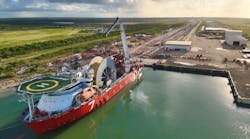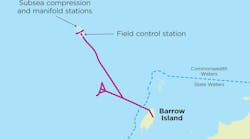Conference in New Orleans to focus on deepwater lessons learned
The Deep Offshore Technology conference scheduled for Nov. 30 – Dec. 2 in New Orleans continues the tradition of this event by offering attendees a wide selection of frontier technology for deepwater operations. The conference, entering its 16th year, attracts attendees from the energy capitals of the world, including Europe, Russia, Australia, Asia, South America, and the US. Drawing on its wide base of experience, the technical conference addresses the complex and changing role of deepwater exploration and production in an evolving energy market.
The scope of this year's conference includes more than 30 technical sessions, from lessons learned in field development to innovative tieback techniques, from field architecture and economics to new riser technology, and from project execution and management to advanced materials. The papers summarized below are a sample of the technology mix that will be available at this year's conference.
Intelligent well design and installation challenges at Na Kika
C.D. Stair
D.B. Hebert
Shell International E&P Inc.
M.E.P. Dawson
Halliburton Energy Services Inc.
S. Jacob
WellDynamics Inc.
The ultra-deepwater Na Kika field (50% Shell/50% BP) in the US Gulf of Mexico required innovative and complex intelli-gent-well designs to develop economically multiple stacked reservoir sequences with a minimum well count. Intelligent well or "remote zonal control" functionality was integrated with the sand face completions to provide isolation between zones during well completion operations, yet allow verification of controlled flow from each zone at the end of the completion. This paper addresses the specific design challenges in intelligent well construction faced by the Na Kika comple-tions team, discusses the develop-ment of innovative solutions, and provides a summary of the successful execution of the four Na Kika intelli-gent wells.
The Na Kika development is 144 mi southeast of New Orleans, Louisiana, in water depths ranging from 5,800 to 7,000 ft. The project is a subsea development comprising five moderately sized independent oil and gas fields tied back to a permanently moored floating development and production host facility that is centrally located in Mississippi Canyon block 474 in 6,340 ft of water.
Individual reservoirs in each of the Na Kika fields contained recoverable reserves as small as 10% of the field totals, making economic development a significant challenge. The play type was characterized as amplitude-supported, structural-stratigraphic traps in the middle to upper Miocene of the Eastern GoM. The moderate size of the average Na Kika field is a direct function of the geologic setting and nature of the channel/levee systems encountered. A wide variety of subfacies is found in these systems with an associated wide range of reservoir quality/ types.
Field development, subsea well completion design, and completion required the marriage of several new technologies and completion methods. While many of the new techniques had been implemented separately in recent completion programs in the GoM and abroad, this completion program brought many of them together for the first time.
Two of the five fields at Na Kika featured multiple-stacked pay sequences, which required stacked completions to enable an economical development concept. However, stacking multiple completions in a single wellbore carries risks, such as differential depletion and crossflow or early water breakthrough. Should those phenomena occur, remedial measures would require costly well interventions. The decision was made to employ intelligent well technology in four of the 10 Na Kika wells to minimize the need for future well interventions and better manage the production uncertainties associated with commingling.
Because of reservoir uncertainties, such as compartmentalization, proximity, and connectivity between gas- and oil-bearing reservoirs as well as aquifer size, a design had to be developed that would provide maximum flexibility to ensure optimal drainage. In two of the five Na Kika fields, the technology chosen to mitigate the uncertainties and enable economic feasibility was an intelligent well completion.
The final development plan for Na Kika featured four intelligent wells that would develop reserves from 11 discrete reservoirs. Required functionality of these wells included competent sand control with low completion skin, remote zonal control, and continuous pressure/temperature monitoring capability for each zone. This functionality enabled producing reservoirs to be commingled or isolated as well as reservoir diagnosis to be performed remotely from the host facility. This would then allow for the optimal assessment of reservoir drainage and depletion management.
This paper discusses the economic drivers for the intelligent well completions at Na Kika in combination with the design challenges in fluid-loss control and zonal isolation during installation. The paper also highlights the novel use of the interval control valves as well as suspension barriers. The discussion results in an illustration of the benefits of the intelligent-well functionality during installation.
Some of the conclusions drawn from the discussion include:
- The Na Kika intelligent well completions were designed to produce from multiple zones in individual wellbores while monitoring and maintaining full control of inflow from each zone
- The capability to commingle multiple zones in select Na Kika wells significantly reduced the well count and potential for intervention, enabling an economic development project
- The capability to commingle zones in a controlled fashion was shown to increase production rates and ultimate recovery from the individual zones
- Intelligent well systems provide operational flexibility and reservoir management capability in multizone comple- tions
- In a multizone completion requiring sand control, the technical challenges around zonal isolation and fluid-loss control can be more complex than the challenges associated with the upper comp- letion design.
Deepwater single-line tiebacks – achieving operability while minimizing cost
R. F. Stoisits, D. C. Lucas, J. K. Sonka
ExxonMobil Development Co.
C. E. Curtis
Scandpower Petroleum Technology
Deepwater subsea tiebacks pose a number of flow assurance issues, such as multiphase hydraulic capacity, flow measurement, hydrate, wax, sand, corrosion, and scale management. Among the most challenging of these issues is hydrate management.
Conventional deepwater subsea tiebacks typically rely on two production lines for hydrate management. During a shutdown, the uninhibited production fluids in the lines are displaced with dehydrated dead crude using a pig. The pig is launched into one production line and driven with the dehydrated dead crude out to the production manifold and back to the facility through the second production line.
For relatively small developments, the cost of a second production line can be prohibitive. In such developments the second production line can be eliminated by using a large-diameter service line in the umbilical for displacement of uninhibited production fluids in the subsea flowline, thereby preventing hydrates during unplanned shutdowns.
This paper discusses the analysis used to establish the single-line hydrate management strategy. Nine hydrate management strategies were evaluated based on safety, environmental considerations, effectiveness, minimal cost, minimal operational complexity, and applicability throughout project life. A conceptual risk assessment identified a number of facility modifications that reduced the risk of the single-line tieback to the level of the dual production line design.
Single production line tiebacks can significantly reduce the cost of deepwater subsea tieback developments. Application of this technology to a deepwater development resulted in a capital cost reduction of approximately 14%.
The capital cost savings realized with a single-line tieback can make marginal projects economically viable. Two effective hydrate management strategies for unplanned shutdown for the deepwater single production line tieback are inhibited live oil displacement and methanol/diesel displacement through a service line in the umbilical. Optimization criteria for application of these two hydrate management strategies are:
- Inhibited live oil displacement be performed when a well is available that will flow naturally (without gas-lift) to the FPSO
- Methanol and diesel displacement be performed otherwise. ;
Mad Dog polyester mooring installation
David Petruska
Hugh Wylie
Jeff Geyer
BP America Inc.
Saskia Rijtema
Heerema Marine Contractors
Aspen subsea tieback – an innovative facilities approach
Ross Sommer
Nexen Petroleum USA Inc.
Davinder Manku
KBR Deepwater Technology Group
The industry has continued to develop smaller "fast track" subsea tieback projects and in general, has improved its track record. Much of this success can be attributed to a better understanding and management of the risks of fast-track execution. Critical equipment contractors have also made great strides in recognizing the need for quicker turnaround of their products to cater to market expectations.
However, the most critical factors in the success of a fast-track subsea tieback are a solid approach to the systems engineering, flow assurance, interface management, and an efficient decision-making process. While the conventional "stage gate" process is often compressed, engineering must still be done in an efficient, well documented manner with a constant focus on risk management and early involvement of the critical contractors. There must also be a willingness to engage engineering specialists for timely resolution of critical engineering issues.
The objective of this paper is to discuss the successful engineering and project execution approach used by the Aspen integrated project team on the Aspen I and II projects. The Aspen story is also one of commercial significance, in that Aspen was originally discovered by a supermajor (BP) with an independent minority partner (Nexen Petroleum USA Inc.), and is now owned and operated by the original minority stake holder.
The Aspen subsea architecture is a simple, reliable, and robust system. It consists of two pipeline end manifolds (PLEMs) laid integral with the flowlines and located between two wells. The PLEMs have tie-ins for two wells each, in addition to a pigging loop connection point. An umbilical termination assembly (UTA) is located to the east of the system, with a composite umbilical routed east of the flowlines to the platform.
A major decision point in the system design was the use of dual versus single externally insulated steel flowlines. Much emphasis was placed on the use of risk-based engineering and operability analysis to arrive at this decision. It was essential to balance the perceived technical and economic advantages of a single-line system with the overall operational flexibility and operational risk mitigation capability of a dual-line system. In the final analysis, the ability to flow separate pressure regimes, consolidate flow during turndown condition to manage slugging, and the general contingency and risk mitigation strategies available with a dual-flowline system were considered essential, especially considering the lack of firm fluid property data.
A great deal of attention was paid to capturing and implementing lessons learned. A number of high-level lessons were noted, including:
- Early involvement of the installation contractor can minimize risk, and a good approach to expediting decision making and management approvals is necessary
- Early involvement of operations personnel and roll out of the "Operability Work-shop" to demonstrate system design was a pivotal exercise that aligned operations and technical staff before committing to the system design
- Technical interface management is key. Complex interface management systems are not necessarily better than a fit-for-purpose (FFP) system. The most important concept is total team involvement and ownership/accountability of interfaces by individuals. Interface management across facilities, drilling, and completion disciplines needs special focus.
Additional lessons learned will be discussed at the presentation of the paper at the DOT conference.
Solid expandable technology: The value of planned installation v. contingency
Chris Carstens
Mike Breaux
Unocal Corp.
Kate Blasingame
Enventure Global Technology
Narrow pore pressure/fracture gradient windows commonly encountered in deepwater in the Gulf of Mexico often require additional casing strings to reach the objective depths. The inability to make accurate predictions for pore pressures and fracture gradients may result in casing strings that do not reach the designed depth. Because of the limited number of conventional casing strings that can be run, operators attempt to push casing points, which can result in loss of circulation, well ballooning, well flows, and other operational difficulties.
Planning a solid expandable tubular in the upper sections of the well design preserves hole size from the onset and allows more casing strings to be run, without having to push casing points to the frac-gradient limit. Preserving hole size contributes to drilling efficiency, reduces equivalent circulation density (ECD), and minimizes risk associated with small hole size in deeper sections of the wellbore.
Running expandable tubulars reactively deeper in the well denotes more of a "survival" mode when operating parameters are more severe. Planned installations allow operators and engineers more time to assess how best to optimize the expandable tubular design. More time also permits analysis of details, such as the shoe joint, base casing connection, and base casing weight, to obtain the desired pass-through and drill-out. Solid expandable tubulars run in the upper hole section still allow for contingency expandable liners in the deeper sections, if required.
The paper compares two deepwater offset wells in the Mississippi Canyon region in the GoM. In the first well, expandable casing was set deep and used as a contingency casing string. The second well incorporated a planned solid expandable tubular high in the wellbore as part of the base design.
This paper explains the planning process for the second well and how this process optimized the use of a planned expandable liner. The planned expandable system in the second well also contributed to operational efficiency. The second well was drilled to depth in 48 days as opposed to the 140 days required by the previous operator in the block to reach an equivalent depth on the first well. Actual pore pressure and fracture gradient data from the first well were used in the design of the second well.
Taking full advantage of the solid expandable tubular technology requires incorporating it into the original well design. Preplanning gives the operator more options to address conditions that can result in the following:
- Optimization of system designs that result in desired post-expansion dimensions
- Reduction of risk due to proper planning and risk analysis
- Flexibility in wellbore design by allowing the drilling engineer to have more strings of casing, thereby reducing the chance of drilling outside the pore pressure/fracture gradient window
- Decrease of non-productive time
- Option of using surface stack technology and still reaching deeper drilling objectives
- Use of lower expansion pressures during installation
Instead of being used as just a remedial solution to problems encountered during drilling or production, solid expandable tubulars are an important construction element to drilling "better" wells. "Better" wells reduce costs, minimize environmental impact, and address challenges proactively.
The current operator was able to capitalize on a wealth of experience and insight by using solid expandable tubular technology and incorporating best practices, lessons learned, and the contract management plan into the design procedures. Since implementing this process, this operator has realized a100% success rate with the application of solid expandable tubulars worldwide.
Registration information
For information about the 16th annual Deep Offshore Technology Conference, Nov. 30 - Dec. 2, in New Orleans, visit the website at www.deepoffshoretechnology.com.








